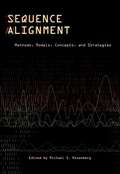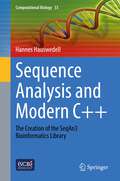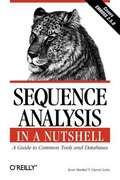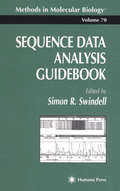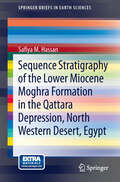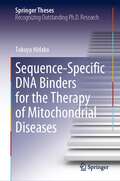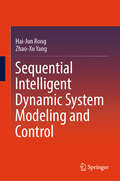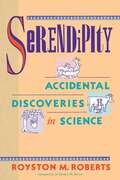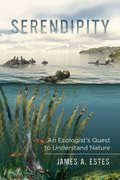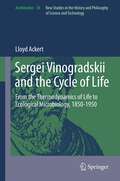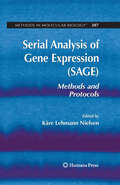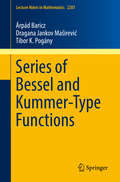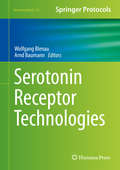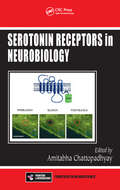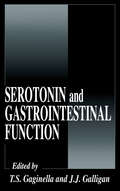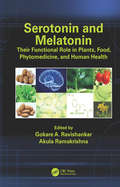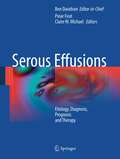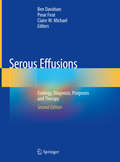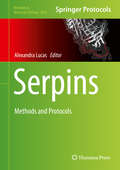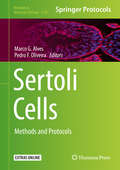- Table View
- List View
Sepup Science and Global Issues: Biology
by University of California at Berkeley Lawrence Hall of ScienceSepup's Science And Global Issues: Biology is a different kind of science course in three important ways. First, it is student-centered, with the goal of helping all students to understand and enjoy science. Second, it is authentic to the way scientists work, and it asks you to begin to think and investigate as a scientist does. Finally, it is organized around important global issues related to sustainability.
Sequence Alignment: Methods, Models, Concepts, and Strategies
by Michael S. RosenbergThe sequencing of the human genome involved thousands of scientists but used relatively few tools. Today, obtaining sequences is simpler, but aligning the sequences--making sure that sequences from one source are properly compared to those from other sources--remains a complicated but underappreciated aspect of comparative molecular biology.
Sequence Analysis and Modern C++: The Creation of the SeqAn3 Bioinformatics Library (Computational Biology #33)
by Hannes HauswedellThis is a book about software engineering, bioinformatics, the C++ programming language and the SeqAn library. In the broadest sense, it will help the reader create better, faster and more reliable software by deepening their understanding of available tools, language features, techniques and design patterns.Every developer who previously worked with C++ will enjoy the in-depth chapter on important changes in the language from C++11 up to and including C++20. In contrast to many resources on Modern C++ that present new features only in small isolated examples, this book represents a more holistic approach: readers will understand the relevance of new features and how they interact in the context of a large software project and not just within a "toy example". Previous experience in creating software with C++ is highly recommended to fully appreciate these aspects.SeqAn3 is a new, re-designed software library. The conception and implementation process is detailed in this book, including a critical reflection on the previous versions of the library. This is particularly helpful to readers who are about to create a large software project themselves, or who are planning a major overhaul of an existing library or framework. While the focus of the book is clearly on software development and design, it also touches on various organisational and administrative aspects like licensing, dependency management and quality control.
Sequence Analysis in a Nutshell
by Darryl Leon Scott MarkelSequence Analysis in a Nutshell: A Guide to Common Tools and Databasespulls together all of the vital information about the most commonly used databases, analytical tools, and tables used in sequence analysis. The book contains details and examples of the common database formats (GenBank, EMBL, SWISS-PROT) and the GenBank/EMBL/DDBJ Feature Table Definitions. It also provides the command line syntax for popular analysis applications such as Readseq and MEME/MAST, BLAST, ClustalW, and the EMBOSS suite, as wel
Sequence Data Analysis Guidebook
by Simon R. SwindellLeading researchers concisely summarize their hands-on experiences and methods for successfully using the most popular sequence analysis software packages available. These experts demonstrate how to examine the data produced by modern automated sequencers, how to assess its quality, how to remove extraneous data, how to align multiple overlapping sequence fragments for either assembly into sequence contigs or comparison with similar sequences from different sources. Procedures for comparing newly derived sequences with the massive amounts of information in the sequence databases are fully covered, as are techniques for performing restriction analysis, searching for open reading frames, calculating the translation products of open reading frames, and making detailed analyses of the expressed "proteins."
Sequence Stratigraphy of the Lower Miocene Moghra Formation in the Qattara Depression, North Western Desert, Egypt
by Safiya M. HassanThe Qattara Depression is part of the Northwestern Desert in Egypt and is home to the second lowest point in Africa at -133 meters below sea level. Therefore, before any projects can be carried out in this area, we must first understand the geology of the land. The present study deals with the high-resolution sequence stratigraphic analysis of the Lower Miocene Moghra Formation outcrops in the Qattara Depression Region. The literature on the sedimentology and sequence stratigraphy of the Moghra Formation has been sparse to date, despite some excellent work over the years by academic and petroleum workers. Moreover, the area studied is within what was once a front-line of World War II, where mine fields and war relics are scattered and cover wide reaches. This has resulted in limited geologic mapping in the past. Thus, great attention is paid in this study to establishing a robust sedimentology and high-resolution sequence stratigraphic framework for the Lower Miocene Moghra Formation. Included are works based on outcrops and, most importantly, new sedimentological and chronostratigraphic information not previously available.
Sequence-Specific DNA Binders for the Therapy of Mitochondrial Diseases (Springer Theses)
by Takuya HidakaThis book describes the author’s work on the development of sequence-specific DNA binders for the therapy of mitochondrial diseases. In the first chapter, the author provides a detailed background of pyrrole–imidazole polyamides (PIPs) and mitochondrial disease research followed by chapters presenting the author's own research and discoveries. Firstly, the developed compounds called MITO-PIPs, which recognize specific sequences in mitochondrial DNA, are presented. The following chapter demonstrates how, by introducing a DNA alkylating reagent into a MITO-PIP that recognizes the adjacent sequence to a target mutation, the copy number of mutated mitochondrial DNA was successfully reduced in live cells. Furthermore, because nuclear DNA is another important target for treating mitochondrial diseases, the author demonstrated that tri-arginine vectors can enhance nuclear uptake of PIPs and improve their biological activity in cells.This work will attract readers’ interest because it paves the way for a transgene-free chemical gene therapy for mitochondrial diseases. The book includes a detailed description of experimental procedures, especially compound synthesis. This description helps readers to have a clear image of the author’s studies and to perform similar and extended studies themselves.
Sequential Intelligent Dynamic System Modeling and Control
by Hai-Jun Rong Zhao-Xu YangThe book offers novel research results of sequential intelligent dynamic system modeling and control in a unified framework from theory proposals to real applications. It covers an in-depth study of various learning algorithms for the permanent adaptation of intelligent model parameters as well as of structural parts of the model. The comprehensive researches on sequential fuzzy and neural controller design schemes for some complex real applications are included. This is particularly suited for readers who are interested to learn practical solutions for controlling nonlinear systems that are uncertain and varied at any time. In addition, the organization of the book from addressing fundamental concepts, and presenting novel intelligent models to solving real applications is one of the major features of the book, which makes it a valuable resource for both beginners and researchers wanting to further their understanding and study about realtime online intelligent modeling and control ofnonlinear dynamic systems. The book can benefit researchers, engineers, and graduate students in the fields of control engineering, artificial intelligence, computational intelligence, intelligent control, nonlinear system modeling, and control, etc.
Serendipity: Accidental Discoveries In Science (Wiley Science Editions Ser. #15)
by Royston M. RobertsMany of the things discovered by accident are important in our everyday lives: Teflon, Velcro, nylon, x-rays, penicillin, safety glass, sugar substitutes, and polyethylene and other plastics. And we owe a debt to accident for some of our deepest scientific knowledge, including Newton's theory of gravitation, the Big Bang theory of Creation, and the discovery of DNA. Even the Rosetta Stone, the Dead Sea Scrolls, and the ruins of Pompeii came to light through chance. This book tells the fascinating stories of these and other discoveries and reveals how the inquisitive human mind turns accident into discovery. Written for the layman, yet scientifically accurate, this illuminating collection of anecdotes portrays invention and discovery as quintessentially human acts, due in part to curiosity, perserverance, and luck.
Serendipity: An Ecologist's Quest to Understand Nature (Organisms and Environments #14)
by James A. EstesTo newly minted biologist James Estes, the sea otters he was studying in the leafy kelp forests off the coast of Alaska appeared to have an unbalanced relationship with their greater environment. Gorging themselves on the sea urchins that grazed among the kelp, these small charismatic mammals seemed to give little back in return. But as Estes dug deeper, he unearthed a far more complex relationship between the otter and its underwater environment, discovering that otters play a critical role in driving positive ecosystem dynamics. While teasing out the connective threads, he began to question our assumptions about ecological relationships. These questions would ultimately inspire a lifelong quest to better understand the surprising complexity of our natural world and the unexpected ways we discover it. Serendipity tells the story of James Estes's life as a naturalist and the concepts that have driven his interest in researching the ecological role of top-level predators. Using the relationships between sea otters, kelp, and sea urchins as a touchstone, Estes retraces his investigations of numerous other species, ecosystems, and ecological processes in an attempt to discover why ecologists can learn so many details about the systems in which they work and yet understand so little about the broader processes that influence these systems. Part memoir, part natural history, and deeply inquisitive, Serendipity will entertain and inform readers as it raises thoughtful questions about our relationship with the natural world.
Serendipity: The Unexpected in Science
by Telmo PievaniFrom the bestselling author of Imperfection, a theory of uncertainty as the very core of the scientific method—and the essence of its wonder.How many times have we looked for something and found something else? A partner, a job, an object? The same thing often happens to scientists: they design an experiment and discover the unexpected, which usually turns out to be very important. This fascinating phenomenon is called serendipity, which takes its name from the mythical Serendip, a place from which, according to a Persian fable, three princes set off to explore the world, making chance discoveries along the way. In Serendipity, the award-winning author of Imperfection Telmo Pievani returns to weave a compelling story about the unexpected in science and its fascinating role in our understanding of the world.Going far beyond the usual examples of penicillin, X-rays, the microwave oven, and Christopher Columbus, Pievani shows that the most surprising stories of serendipity in the history of science reveal profound aspects of the logic of scientific discovery. In this book, he presents for the first time: an archaeology of the idea; a taxonomy of serendipitous discoveries; an &“ecology of serendipity&” (the surrounding conditions and factors that can promote it); and lastly, a theory of serendipity (why it occurs so frequently in so many sciences). From Zadig to Sherlock Holmes, Pievani shows that such great discoveries are not just the product of luck. Instead, serendipity comes from a mix of cunning, curiosity, sagacity, imagination, and accidents caught on the fly. Serendipity illuminates how much we don&’t know and how much we don&’t even know we don&’t know. Above all, Pievani reminds us that the human brain is of a piece with the world it is investigating—a world so much bigger than our knowledge—and it has also evolved within that world, adapting as it has to.
Serengeti IV: Sustaining Biodiversity in a Coupled Human-Natural System
by John M. Fryxell Anthony R. E. Sinclair Kristine L. Metzger Simon A. R. MdumaThe vast savannas and great migrations of the Serengeti conjure impressions of a harmonious and balanced ecosystem. But in reality, the history of the Serengeti is rife with battles between human and non-human nature. In the 1890s and several times since, the cattle virus rinderpest at last vanquished in 2008 devastated both domesticated and wild ungulate populations, as well as the lives of humans and other animals who depended on them. In the 1920s, tourists armed with the world s most expensive hunting gear filled the grasslands. And in recent years, violence in Tanzania has threatened one of the most successful long-term ecological research centers in history. "Serengeti IV," the latest installment in a long-standing series on the region s ecology and biodiversity, explores the role of our species as a source of both discord and balance in Serengeti ecosystem dynamics. Through chapters charting the complexities of infectious disease transmission across populations, agricultural expansion, and the many challenges of managing this ecosystem today, this book shows how the people and landscapes surrounding crucial protected areas like Serengeti National Park can and must contribute to Serengeti conservation. In order to succeed, conservation efforts must also focus on the welfare of indigenous peoples, allowing them both to sustain their agricultural practices and to benefit from the natural resources provided by protected areas an undertaking that will require the strengthening of government and education systems and, as such, will present one of the greatest conservation challenges of the next century. "
Sergei Vinogradskii and the Cycle of Life
by Lloyd AckertThis is one of those biographies that provide a window onto the broader understanding of science in its social and cultural context. Using Sergei Nikolaevich Vinogradskii's career and scientific research trajectory as a point of entry, this book illustrates the manner in which microbiologists, chemists, botanists, and plant physiologists inscribed the concept of a "cycle of life" into their investigations. Their research transformed a longstanding notion into the fundamental approaches and concepts that underlay the new ecological disciplines that emerged in the 1920s. The book presents a reconstruction of significant episodes of Vinogradskii's laboratory practices and the role of theory in their development. It paints the broader picture of the history of ecology, microbiology and soil science and how these are uniquely united: through the concept of the cycle of life.
Serial Analysis of Gene Expression (SAGE)
by Kåre Lehmann NielsenThis book facilitates the introduction of SAGE into the laboratory and provides a framework for interpreting and comparing data derived from SAGE experiments. SAGE studies encompass 50,000 tags and can provide detailed knowledge of the 2000 most highly expressed genes in the tissue sample. The SAGE protocols presented are detailed, fully annotated, and tested, and are all written by experienced SAGE researchers from around the world.
Serial Violence: Analysis of Modus Operandi and Signature Characteristics of Killers (ISSN)
by William J. Birnes Robert D. KeppelLinking the murders of an alleged serial killer to successfully present a case in court involves a specific methodology that has been scrutinized by the judicial system but is largely absent in the current literature. Serial Violence: Analysis of Modus Operandi and Signature Characteristics of Killers fully explains the process of finding the nexus
Series of Bessel and Kummer-Type Functions (Lecture Notes in Mathematics #2207)
by Árpád Baricz Dragana Jankov Maširević Tibor K. PogányThis book is devoted to the study of certain integral representations for Neumann, Kapteyn, Schlömilch, Dini and Fourier series of Bessel and other special functions, such as Struve and von Lommel functions. The aim is also to find the coefficients of the Neumann and Kapteyn series, as well as closed-form expressions and summation formulas for the series of Bessel functions considered. Some integral representations are deduced using techniques from the theory of differential equations. The text is aimed at a mathematical audience, including graduate students and those in the scientific community who are interested in a new perspective on Fourier–Bessel series, and their manifold and polyvalent applications, mainly in general classical analysis, applied mathematics and mathematical physics.
Serotonin Receptor Technologies
by Wolfgang Blenau Arnd BaumannReflecting a vast amount of new information concerning the functional characteristics of the various 5-HT receptor subtypes and the Na+-dependent serotonin transporter (SERT), this volume provides state of the art methodologies currently applied in serotonin research from leading experts in the field. Serotonin Receptor Technologies describes approaches that vary from molecular biological and biochemical techniques (e. g. , regarding receptor dimerization), fluorescence microscopy and imaging applications, flow cytometry, the use of organotypic slice and cell cultures to the generation of genetically modified animal models and the development of sophisticated behavioral tests, thus covering a wide spectrum of techniques to study serotonergic signaling in detail. Written for the popular Neuromethods series, chapters include the kind of detail and practical advice that ensures successful results in the lab. Authoritative and convenient, Serotonin Receptor Technologies serves to foster both basic and translational research aiming to further deepen our understanding of the various facets of aminergic systems, as well as to aid research on similar problems with related GPCRs and neurotransmitter transporters.
Serotonin Receptors in Neurobiology (Frontiers in Neuroscience)
by Amitabha ChattopadhyayA number of developments spanning a multitude of techniques makes this an exciting time for research in serotonin receptors. A comprehensive review of the subject from a multidisciplinary perspective, Serotonin Receptors in Neurobiology is among the first books to include information on serotonin receptor knockout studies. With contributions from l
Serotonin and Gastrointestinal Function (Handbooks In Pharmacology And Toxicology Ser. #23)
by Timothy S. Gaginella James J. GalliganSerotonin and Gastrointestinal Function provides a comprehensive review of current research into the mechanisms by which serotonin acts on gastrointestinal tissues. This book covers neurochemistry, physiology, pharmacology, and clinical issues relevant to serotonin in the gastrointestinal tract. The editors have brought together the most relevant information from the molecular to the clinical level. Each chapter is written by investigators experienced in research on serotonin's actions in the gut. This book will be useful to basic scientists, clinical investigators, graduate and postgraduate students.
Serotonin and Melatonin: Their Functional Role in Plants, Food, Phytomedicine, and Human Health
by Gokare A. Ravishankar Akula RamakrishnaSerotonin and Melatonin: Their Functional Role in Plants, Food, Phytomedicine, and Human Health highlights the significance of the plant sources of serotonin and melatonin in the fields of medicine, agriculture, and food science. Over the last few decades, an enormous amount of research data has been generated on these two neurotransmitters/plant signalers. This book covers topics regarding the occurrence of serotonin and melatonin in medicinal plants and food value plants with their implications for human health, the role of serotonin and melatonin in plant growth development, functions of melatonin and serotonin in the environmental adaptation of plants, and the implications of these molecules in human disorders and treatments. This volume should appeal to scientists and other professionals engaged in basic and applied research on the relevance of serotonin and melatonin to plants, animals, and humans. Features Reviews the global scientific literature and the experimental data of the authors on the occurrence of serotonin and melatonin in medicinal and food value plants and its implications for human health Explains in detail the role of serotonin and melatonin in plant growth development Helps in understanding the complex functions of melatonin and serotonin in the environmental adaptation in plants Discusses the importance of the development of transgenic plants with high amounts of serotonin and melatonin. Describes the current understanding of serotonin and melatonin in human disorders, and also their relevance in the treatment of specific health conditions. Written by acknowledged experts from across the world
Serous Effusions
by Claire W. Michael Pinar Firat Ben DavidsonSerous (peritoneal, pleural and pericardial) effusions are a frequently encountered clinical finding in everyday medical practice and one of the most common specimen types submitted for cytological evaluation. The correct diagnosis of effusions is critical for patient management, as well as for prognostication and yet many clinicians find diagnosis and treatment of cancer cells in effusions very challenging. Featuring multiple microscopic illustrations of all diagnostic entities and ancillary techniques (immunhistochemistry and molecular methods), this book provides a comprehensive, authoritative guide to all aspects of serous effusions, including etiology, morphology and ancillary diagnostic methods, as well as data related to therapeutic approaches and prognostication. Section one covers diagnosis for benign and malignant effusions including the etiological reasons for the accumulation of effusions that provides the reader with the full spectrum of differential diagnoses at this anatomic site. Section Two discusses biology, therapy and prognosis highlighting clinical approaches that may be of value to patients and the movement towards personalized medicine and targeted therapy. Written by experts in the field internationally, Serous Effusions will provide an indispensible guide to all aspects of current practice for cytopathologists, cytotechnicians, pathologists, clinicians and researchers in training and practice.
Serous Effusions: Etiology, Diagnosis, Prognosis and Therapy
by Claire W. Michael Pinar Firat Ben DavidsonThis revised and updated second edition contains multiple microscopic illustrations of all diagnostic entities and ancillary techniques, providing a comprehensive, authoritative guide to all aspects of serous effusions. It now includes the many new antibodies which have been tested since the previous edition, as well as a discussion on next-generation sequencing and molecularly targeted therapy.Section one covers diagnosis for benign and malignant effusions while section two discusses biology, therapy, and prognosis highlighting clinical approaches that may be of value.Serous Effusions provides an indispensable guide to all aspects of current practice for cytopathologists, cytotechnicians, pathologists, clinicians and researchers in training and practice.
Serpins: Methods and Protocols (Methods in Molecular Biology #1826)
by Alexandra LucasThis volume explores the latest methods used to study and define serpin molecular structure, basic protease inhibition, serpin targets, and the roles of serpin in biology and disease using animal models. The chapters in this book cover topics such as crystallography and phage display, peptide design, phospholipid binding, and thrombus formation to microbiome analysis and development. Written in the highly successful Methods in Molecular Biology series format, chapters include introductions to their respective topics, lists of the necessary materials and reagents, step-by-step, readily reproducible laboratory protocols, and tips on troubleshooting and avoiding known pitfalls.Cutting edge and authoritative, Serpins: Methods and Protocols is a valuable resource for researchers and scientists interested in learning more about this evolving field.
Sertoli Cells: Methods and Protocols (Methods in Molecular Biology #1748)
by Pedro F. Oliveira Marco G. AlvesThis detailed volume explores the use of Sertoli cells as models in male reproductive biology or as supporters for other cell types, and it answers the need for standardized protocols for their in vitro culture. Prepared for non-specialists as well as experienced researchers that may be interested in a multidisciplinary approach to study these cells, the book examines these remarkable cells that present some unique features that go far beyond the physical and nutritional support of spermatogenesis. Written for the highly successful Methods in Molecular Biology series, chapters include introductions to their respective topics, lists of the necessary materials and reagents, step-by-step, readily reproducible laboratory protocols, and tips on troubleshooting and avoiding known pitfalls. Authoritative and practical, Sertoli Cells: Methods and Protocols serves as a valuable resource for experienced researchers in reproductive biology, particularly andrologists, but also for future investigators and young students starting to study these extraordinary cells.
Serum/Plasma Proteomics
by David W. Greening Richard J. SimpsonBlood science has become a cornerstone of multiple disciplines, including clinical chemistry, disease diagnosis, and therapeutic monitoring. Over the past decade, we have witnessed the advent of increasingly powerful proteomics technologies that allow greater fundamental insights into the blood proteome. These technological improvements have, in part, fuelled the quest for the discovery of novel blood-based biomarkers of disease. Serum/Plasma Proteomics: Methods and Protocols is a comprehensive resource of protocols for areas, pre-analytical through to analytical, of plasma and serum proteomics. Divided into five convenient sections, this detailed volume covers fractionation strategies for in-depth blood proteome analysis, defined procedures for blood collection, handling and storage, detailed protocols for performing both antibody-based and non-antibody based quantitative assays, proteome analysis of blood cell compartments, circulating nanomebraneous vesicles and blood-related fluids, and finally data management, statistical design, and bioinformatic challenges. This book, contributed to by leading experts in the field, provides a valuable foundation for the development and application of blood-based proteomics. Written in the highly successful Methods in Molecular BiologyTM series format, chapters contain introductions to their respective topics, lists of the necessary materials and reagents, step-by-step, readily reproducible laboratory protocols, and notes on troubleshooting and avoiding known pitfalls. Authoritative and easily accessible, Serum/Plasma Proteomics: Methods and Protocols, with its well-honed methodologies, seeks to serve both professionals and investigators new to the field in an effort to further our knowledge of this fundamental science.

